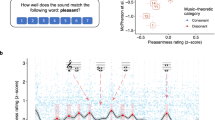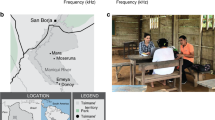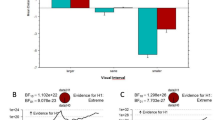Abstract
Synaesthesia is the involuntary physical experience of a cross-modal linkage — for example, hearing a tone (the inducing stimulus) evokes an additional sensation of seeing a colour (concurrent perception). Of the different types of synaesthesia, most have colour as the concurrent perception1, with concurrent perceptions of smell or taste being rare2,3. Here we describe the case of a musician who experiences different tastes in response to hearing different musical tone intervals, and who makes use of her synaesthetic sensations in the complex task of tone-interval identification. To our knowledge, this combination of inducing stimulus and concurrent perception has not been described before.
Similar content being viewed by others
Main
E.S. is a 27-year-old professional musician who is female, right-handed and of average intelligence4 (IQ, 115). Whenever she hears a specific musical interval, she automatically experiences a taste on her tongue that is consistently linked to that particular interval (Table 1). Besides this exceptional interval-to-taste synaesthesia, she also reports the more common tone-to-colour synaesthesia, in which each particular tone is linked to a specific colour (for example, C and red; F sharp and violet).
Both synaesthetic perceptions have always been consistently reproducible. We repeatedly tested E.S. for over a year and have confirmed that her interval-to-taste synaesthesia is unidirectional: she does not hear tone intervals when exposed to taste. In addition, E.S. applies this synaesthesia in identifying tone intervals (which is evidence of a synaesthesia–cognition cascade).
To assess the influence of E.S.'s synaesthetic gustatory perception on her ability to identify tone intervals, we adapted the Stroop task5 (for methods, see supplementary information). Four selected tone intervals (seconds and thirds) were presented while applying four differently tasting solutions (sour, bitter, salty and sweet) to E.S.'s tongue. Her task was to identify the tone intervals by pressing a particular button for each interval on a computer keyboard. Reaction times and errors were measured for trials in which the applied taste was either congruent or incongruent with the tone interval; tone intervals were also presented without taste stimulation.
We found that E.S.'s tone-interval identification was perfect and was significantly faster during the congruent condition compared with all the other conditions (Fig. 1). Five non-synaesthetic musicians were tested as controls using the same procedure: no significant between-condition differences were found. The reaction times of the controls were comparable to those of E.S. in the no-taste condition (Fig. 1).
In the ‘Taste’ condition, musical intervals were presented while solutions of different taste (citric acid, 20 g litre−1; quinine, 60 mg litre−1; salt, 10 g litre−1; sucrose, 120 g litre−1) were delivered to the subject's tongue. The ‘Conceptual’ condition followed the same procedure, except that words describing the tastes, instead of the tastes themselves, were visually presented 2 s before the tone interval. Non-parametric randomization tests were used for statistical comparison. For E.S., all statistical comparisons in the taste condition were associated with P values of less than 0.01 (*P<0.05, **P<0.01, ***P<0.001). For control subjects and for the conceptual condition, none of the comparisons revealed significant differences. The reaction time of E.S. in the no-taste condition is similar to those of the controls, but is faster in the congruent condition and slower in the incongruent condition.
To exclude conceptual priming effects as an explanation for these results (for example, the subject might imagine sourness when presented with ‘sour’ as either a taste or word), we also tested E.S. by showing her the word(s) describing each taste. We found no between-condition difference in this conceptual task (Fig. 1).
Together, these results indicate that E.S.'s performance in the gustatory Stroop task is most likely to be due to her extraordinary type of synaesthesia, in which a complex inducing stimulus leads to a systematic, concurrent gustatory sensation. This case differs from another gustatory synaesthete, S., who reported blended gustatory sensations (such as specific meals) in response to simple auditory stimuli (tones and sounds)2. E.S.'s application of her synaesthetic sensations in identifying tone intervals — a complex task that requires formal musical training — demonstrates that synaesthesias may be used to solve cognitive problems.
References
Rich, A. N. & Mattingley, J. B. Nature Rev. Neurosci. 3, 43–52 (2002).
Luria, A. R. The Mind of a Mnemonist (Basic Books, New York, 1969).
Ward, J. & Simner, J. Cognition 89, 237–261 (2003).
Horn, W. Leistungsprüfsystem (Hogrefe, Göttingen and Bern, 1983).
Stroop, J. R. J. Exp. Psychol. 18, 643–662 (1935).
Author information
Authors and Affiliations
Corresponding author
Ethics declarations
Competing interests
The authors declare no competing financial interests.
Supplementary information
Rights and permissions
About this article
Cite this article
Beeli, G., Esslen, M. & Jäncke, L. When coloured sounds taste sweet. Nature 434, 38 (2005). https://doi.org/10.1038/434038a
Published:
Issue Date:
DOI: https://doi.org/10.1038/434038a
This article is cited by
-
Wenn die Terz nach Sahne schmeckt
HNO Nachrichten (2018)
-
Wine and music (I): on the crossmodal matching of wine and music
Flavour (2015)
-
The brain of synesthetes
Rendiconti Lincei (2014)
-
Synesthesia and Migraine: Case Report
BMC Neurology (2010)
-
Assessing the Role of Sound in the Perception of Food and Drink
Chemosensory Perception (2010)
Comments
By submitting a comment you agree to abide by our Terms and Community Guidelines. If you find something abusive or that does not comply with our terms or guidelines please flag it as inappropriate.




